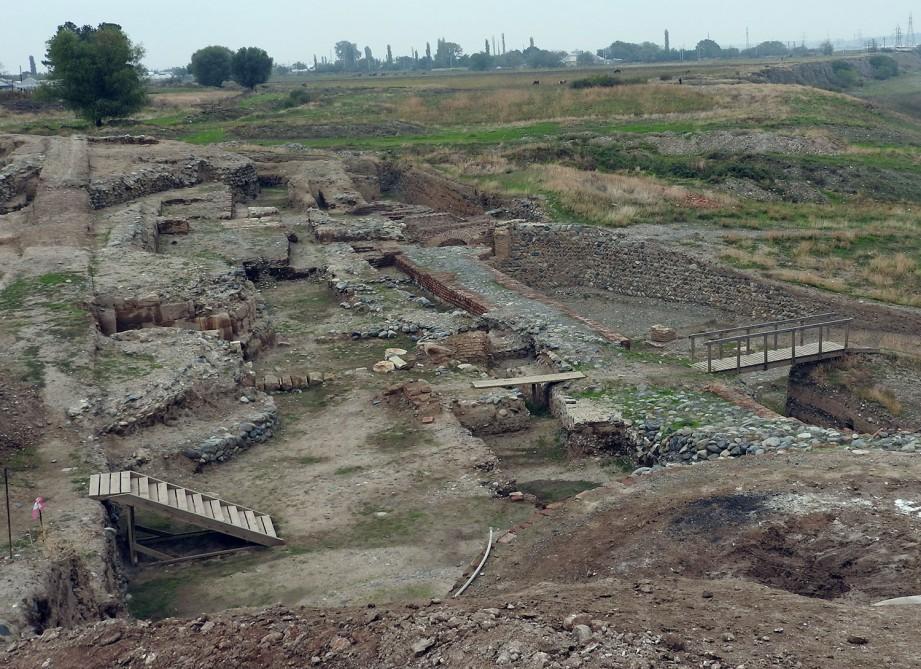Japanese archaeologist carries out excavation in ancient Damjili cave

By Laman Ismayilova
Archaeological excavations are underway in the world-famous Damjili cave in Azerbaijan`s Gazakh region.
The archaeological expedition is based on a tripartite memorandum signed between the Azerbaijan Institute of Archeology and Ethnography, the Avey State Historical and Cultural Reserve and the University of Tokyo, Trend reported.
The purpose of the excavations is to identify objects and tools of the Stone Age, an ancient settlement, and to prove that the people living there were local residents, as well as to determine the relations between the Neolithic and Mesolithic periods.
The archaeological excavations are led by Yoshihiro Nishiaki, Professor at the University of Tokyo. The workers of Azerbaijan Institute of Archeology and Ethnography – Mansur Mansurov, Yagub Mammadov, Ulviyya Heydarova and Ajdar Babayev – also took part in the excavations.
In 2015, at the initiative of the Culture Ministry, a large delegation led by Professor Yoshihiro Nishiaki was invited to conduct exploration searches at the foothills of Avey.
A tripartite international memorandum was signed to explore the world-wide archaeological heritage complex, including Damjili cave, and camp around the cave, on the Avey Mount.
The aim of the international expedition is to prove that the area is an ancient human settlement, and to obtain material evidence from the Neolithic era.
Archeological excavations at Damjili cave started in August 2016. Exploratory excavations were carried out in 10 different directions.
Neolithic ruins, hearth places, bones, samples dating the late Middle Paleolithic were discovered at the depth of 4 meters. Research was carried out at Japanese laboratories to determine the periods of the material culture found in Damjili.
Damjili is the largest of the 30 caves of the Stone Age discovered on the territory of Gazakh region in mid 1950s. Located at the foot of Avey Mount, its area is about 460 square meters and the height is four meters.
The cave, opened in 1953 by Azerbaijani scientists Mahammadali Huseynov, is the first monument of the Stone Age discovered in Azerbaijan. It also has similarities with the ancient settlement of Goytepe of the Neolithic period, which is located in the neighboring Tovuz region.
A number of various stone tools, arrowheads, flint knives, bones of animals were discovered in the cave during excavations. Traces of ochre were also found in the cave. The sediment layers, in which the ochre was found, are mixed with younger ones, which suggests that the use ochre dates back to the Mousterian culture.
Avey Mount is one of the peaks in the Small Caucasus Mountains located between Georgia and Gazakh region.
There is an ancient Albanian temple on the top of the mount. The word Avey is interpreted as “lunar house”.
Many temples, old settlements, ancient graveyards and about 30 artificial caves from Paleolithic times have been discovered on the slopes of the mount. For this reason, the State Historical and Cultural Reserve Avey was set up there in 1989. Damjili cave is also one of the main sites of the reserve.
Another interesting point about Damjili cave is a spring with the same name. Azerbaijani poet Samad Vurgun once said that Damjili spring is the 8th miracle of the world and the 1st one of Azerbaijan.
The spring trickles down from the flinty ceiling of the cave through narrow rocky splits. Water drops, dripping from huge 1,000-meter high rocks, create a magical world of sounds.
---
Laman Ismayilova is AzerNews’ staff journalist, follow her on Twitter: @Lam_Ismayilova
Follow us on Twitter @AzerNewsAz
Here we are to serve you with news right now. It does not cost much, but worth your attention.
Choose to support open, independent, quality journalism and subscribe on a monthly basis.
By subscribing to our online newspaper, you can have full digital access to all news, analysis, and much more.
You can also follow AzerNEWS on Twitter @AzerNewsAz or Facebook @AzerNewsNewspaper
Thank you!
